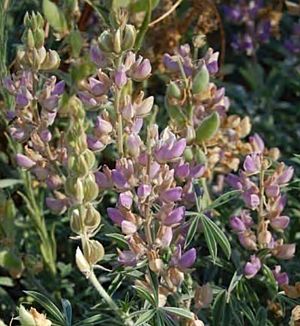Summer lupine facts for kids
Quick facts for kids Summer lupine |
|
|---|---|
 |
|
| Scientific classification | |
| Genus: |
Lupinus
|
| Species: |
formosus
|
The Lupinus formosus, also known as the summer lupine or western lupine, is a beautiful flowering plant. It belongs to the legume family, which includes peas and beans. This plant grows naturally in parts of California and Oregon in the United States.
Contents
Why Summer Lupine Can Be Harmful
Summer lupine is known to be a poisonous plant for certain animals. Even though it is not an endangered plant, some cattle farmers try to remove it. This is because the plant can cause a serious problem called "crooked calf disease" in their animals.
The summer lupine, along with five other types of lupines, is poisonous. It stays toxic from when it first starts growing in spring until its seed pods break open in late summer or early fall. The younger the plant is, the more harmful it can be to animals.
How It Affects Animals
Summer lupine contains natural chemicals that can be harmful to livestock. When pregnant animals like cows, sheep, or goats eat this plant, it can cause birth defects in their babies. For example, goat kids might be born with bent joints or a cleft palate.
Animals that eat too much of this plant can show signs of poisoning. They might have trouble walking, seem clumsy, or have weak muscles. In severe cases, they might fall down and even die.
Where Summer Lupine Grows
This plant likes to grow in dry areas. You can often find it on slopes under pine trees or in clay soils. It also grows in grasslands and coniferous forests.
You can find summer lupine in mountain ranges like the San Jacinto, Santa Rosa, and San Gabriel Mountains. It grows all over California, except for the eastern deserts and the high plateaus east of the Sierra Nevada mountains.
Blooming Season
The summer lupine blooms, or produces its flowers, from April all the way through August. This long blooming period is how it gets its common name, "summer lupine."
Summer Lupine and Butterflies
This plant is very important for several types of butterflies. It is one of the main food sources for the caterpillars of the endangered mission blue butterfly. This means the caterpillars eat the leaves of the summer lupine to grow.
It also serves as a host plant for the caterpillars of other beautiful butterflies. These include the Acmon blue, arrowhead blue, Melissa blue, silvery blue, and sooty hairstreak butterflies.
Different Types of Summer Lupine
There are two main types, or varieties, of Lupinus formosus:
- Lupinus formosus var. robustus: This type is found only in the Sierra Nevada mountains and the Southern Coast Ranges of California.
- Lupinus formosus var. formosus: This type is more common and can be found in a wider area.

